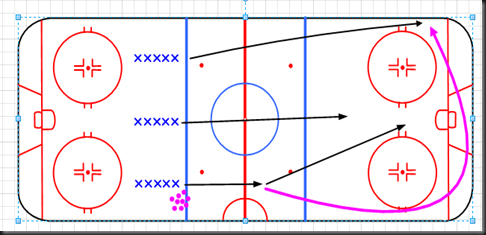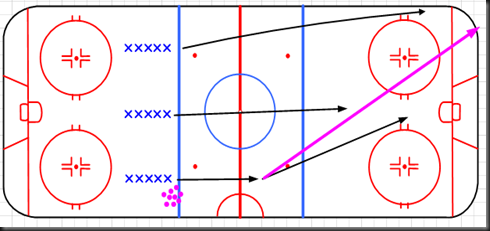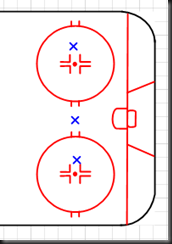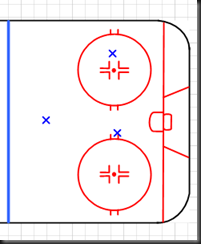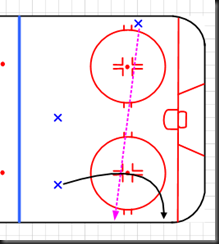Your cart is currently empty!
Category: exercise
-
Monday Clinic
Tonight’s clinic was a lot of fun and I’m happy with my performance, despite a number of falls. Since the falls were because I was pushing things, I’m good with that.
Skating drill started with coach putting us on the goal-line and having us crouch as low as we could – then skate to the other goal-line in that position. And back. His point being that everyone is typically standing too straight while they skate. Then down and back at speed, followed by sprints from goal-line to blue-line and goal-line to center ice. His point after the sprints that what we’d just done took a little less than a minute and that’s how long shifts should be in the game – not the two or three minute shifts that are typical.
The regular drill was three skaters on the attack, this time with one of us dumping the puck in, rather than relying on the coach to do it.
So each rep was both different, based on how well whoever had the puck could dump it in, and more realistic to our level of play. Especially since some of us, including myself, simply don’t have the oomph to wrap the puck with any kind of power. For us, the dump in was cross ice
This was because the goalie had been instructed to play the puck if it was piddling along the boards from a sucky attempt to wrap it, and our rep would stop if he was able to.
The other thing he stressed was to form a triangle, not a straight line, on the attack. With the straight line, a defender can move out to the center man and with two players there a pass likely won’t make it to the player in the far circle. With a triangle there are more options.
My first rep at left-wing was very successful. I got the puck off the boards and made a nice backhand pass that was right on target to the right-wing and he scored with it. Yay!
My second rep at right-wing was less so. After I dumped the puck in and headed for the net, the left-wing passed it behind me.
I don’t turn to the right so good still, so this had the predictable result of me hitting the boards at speed. Much like last week and with much the same result – some ribs that are still tender.
A bit later, the coach upped the ante and announced that he’d be playing D for the rest of the reps to put pressure on us. “You all know who I am. If you shoot the puck through me … I will kill you.”
So on my first rep at left-wing for this change I got to the puck in the corner and the blade of my stick went right through the slot in the Zamboni doors. Before I could back up a bit to pull it out, the coach was on me with some gentle jostling and crosscheck or two. I got my stick out, but went down on the ice, but was able to whack the puck back to the high slot area. Of course, the guy I thought would be there had moved to the point along the boards, so the puck sailed out of the zone.
What I should have done is left off with trying to free the stick and protected the puck with my skates until I could see a teammate along the boards and just kick it free to him. Or at least looked up to see where someone was before I whacked it.
For the final instance of my ass hitting the ice, I was again at left-wing and dump in was cross ice. The puck rebounded from the boards to the goal-line and rather than trying to pass from there, I decided to scoop it up as I went by, take it behind the net, and pass from there. Good idea, poor execution. My skates hit a rut behind the net and I went down, but managed to scramble back to the puck and pass it.
-
Monday Clinic
So did a week of interval training make any discernable difference in my performance? Maybe.
I talked to the coach before practice about changes I’d made in my workout routine this week and he thought they were okay. He also seems to think that I’d be fine playing in the rookie game, but I’m still hesitant – I don’t care so much about the skills, but although I can stop and turn, it does tend to require some advance planning on my part.
Drills are one thing, but with an opposing team out there I’m concerned that I’ll run into someone (or the goalie) and hurt them. I’d also like to be able to make it through the entire practice without feeling like I’ll blow chunks first.
It struck me this week, after last Monday’s revelation, as I looked into the difference between aerobic and anaerobic, that everything I’ve ever done as far as exercise has been aerobic – hiking, kayaking, golf … all aerobic. So starting something anaerobic for the first time at forty-something and having to build an entirely new type of muscle may be pretty stupid. Oh, well.
First skating drill tonight was much like last week, trying to get us into that hop-turn from a standing start.
Starting on the blue-line (top arrows) and facing the side boards, he first had us just step sideways to the other blue-line. The “hop” off the leading foot started to feel more natural during this drill, but after a few reps of this we were back to adding the turn. It might be that I’m not making enough of a hop to get fully turned at the start.
Next (bottom arrows) we’re back on the blue-line, but this time facing down-ice. Forward to the other blue-line, with the first three to five strides being quick steps. Then stop and the return is backwards.
The coach is stressing to everyone that he doesn’t want to see anyone doing crossovers backwards in this drill – strictly power-skating. This is easy for me to comply with, because I have no f-ing clue how to do a backward crossover. I’ve watched it and watched it, but it still seems like magic to me – the way the feet move just shouldn’t wind up in the body going the way it does.
Puck drill is much the same as last week, but there are enough people to have three skaters. It simulates recovering the puck in your own zone after it’s been dumped in by the opposing team.
Skater 1 dumps the puck in behind the net. Whoever’s fastest of the other two (not me) heads for it. The other one makes for the boards at the blue-line – bail-out man. Skater 1, meantime, skates into the zone, playing defense until we have the puck, then doubles back to head up-ice. Whoever stopped the puck passes to the bail-out, and we head up-ice, passing, for a shot on goal.
Lots of yelling by coach on everyone’s reps about the bail-out not being in position and the pass not going to him first. Also more stressing, like last week, about not stopping in the neutral zone to wait for the puck – keep moving, zig-zag, even come back down-ice, but don’t stop and don’t turn around to skate backwards.
Good point that skating backwards to take a pass on offense is going to let the defender set himself in your path. Even in a no-check league, when you run into him backwards there’ll be no penalty and you’ll be face down on the ice.
I made four reps of this (it was two last week) and had to sit on the bench for a bit to catch my breath, but I made it back onto the ice for two more reps before the end of practice. That’s better than last week, but too soon to tell if the improvement will be consistent.
I was happy with my passing during this drill. I flubbed a couple, but so did everyone and my flubs weren’t the worst. On one I got the puck near the goal line and made a nice backhand pass across the slot that was right on target. I also took a pass on one drive and got the shot on goal – that’s an accomplishment in two ways: 1) my shot was on goal instead of six feet to the right; and, B) I was at the goal to take the pass instead of out in the neutral zone struggling to catch up.
Accomplishments are all about perspective.
-
A Stab at Interval Training
So Monday’s clinic taught me that I needed to add anaerobic exercise to my routine. Today I made a stab at that.
First, this is not a recommendation or suggestion for what you should do. I’m not at all knowledgeable about exercise, fitness, or nutrition – I’m just trying stuff and relating the results. It’s entirely possible that I’m killing myself with this, so emulate at your own risk.
That being said, my understanding is that I need to add short periods of intense activity (anaerobic) to my longer, less strenuous efforts (aerobic). Although the coach recommended blue-line to blue-line sprints during public skating, work and money prohibit me from going skating every day. The impact makes running or a treadmill out of the question for me, so I decided to add more intensity to my time on the elliptical.
Using the machine’s built-in interval setting with a base resistance of 5, my 30-minute workout looks like this:
Starting slow today, trying to avoid that whole killing-myself thing, I went with increased intensity every fourth minute (arrows). The machine handles adjusting the incline and resistance, I just had to increase my strides.
I slowed my normal pace to the 100-120 strides per minute range and increased it on the red arrows to 180-200. Well, until about the twenty minute mark, when I really started wearing down and settled for 150+.
This is going to be a work-in-progress as I try to find a base resistance level and strides that will start taking care of that anaerobic-thing.
-
Back at the Hockey Clinic
Yes, I’d been planning to start back with the lessons in January, but I had several things that would have interfered with Monday nights and didn’t want to start if I couldn’t go every week right away.
Did the three months of exercise get me in better shape? Well …
First drill: Line up on the blue-line, facing the side boards. Now we’re going to skate to the red-line and stop, but we’re facing the side boards, so we have to turn. The way I’m lined up, the red-line is to my right, so my first instinct is to turn my right foot and push off with my left … as in many cases, my first instinct is wrong.
I’m supposed to lift my left foot, cross it over, and push-off/jump off my right foot. This feels very awkward.
Stop at the red-line, then go back, this time lifting and crossing over the right foot, while pushing off with the left.
A few reps of this and I’m getting the hang of it – better pushing off with my right foot, but I’d expect that. I’m feeling okay, not out of breath, so I start feeling confident that the exercise did some good.
Next drill is similar, but blue-line to blue-line and we start from our knees facing the far blue-line. Oddly this feels more comfortable to me if I’m pushing off my left foot … from both knees, I get my left foot under me and push up and out, getting my right foot under me.
A few reps of this and I’m still feeling pretty good. I get out of breath once we stop to get ready of for the next drill, but during it I was okay. I was the slowest at both of these, but I haven’t been skating a lot, so I’m okay with that as I get better.
Next up is some puck-handling with our feet – trying to get us to kick the puck to our sticks along the boards or to control a pass that comes to our feet.
So four or five of us around each circle, and first it’s just feet. Stop the puck with your feet and kick it to the next person.
After some time of doing this, we change it up and pass with the stick, but stop the puck with our feet – kick it out to our stick after stopping it.
This is harder work than it sounds like. At least for me, it’s awkward and a lot of work to maneuver from a standing start, so when the pass is off it’s a lot of work move to stop it.
I was not the worst in my group at this, so that made me happy.
Last was a passing and shooting drill. Two lines at the blue-line. One player dumps the puck in along the boards while the other heads to the other side to stop it.
Once he has it, both head up ice, passing along the way, and take a shot on goal.
Two things the coach was stressing in this drill:
1) Stay together. If one of the pair is slow (me) the other (everyone else) needs to stay with him, not just blast up the ice. We want to attackers in order to split the goalie’s attention.
2) Keep moving. The faster skater shouldn’t just stop and wait for the slower – when he catches up he’ll just blow by, so keep skating. Side to side or even skating back to the slower skater is preferable to just stopping and waiting.
This is where it fell apart for me. I’m slow, so I’m skating all-out the length of the ice for this drill. I made it through two reps and when I got back in line after the second one, I was out of breath, dizzy, and nauseated.
So I headed to the bench for a rest and frustration. The coach came over to talk to me while I was sitting there – he remembered me from the few times I was there last year.
I told him, “I’ve spent the last two months on the elliptical five times a week to get ready for this, I don’t understand.”
“That’s aerobic,” he said.
I gave him my best look of incomprehension. It’s impressive, I get to use it a lot.
“This is anaerobic,” he explained.
Well … crap … so I’ve spent the last two months doing the wrong thing?
He explained that aerobic was still important so I’d have legs in the third period.
Great … I’ve prepared myself well for the third period, I just can’t get through the first shift.
His recommendation? I can’t run, knees and shins won’t take the impact, so he suggested pushing myself in intervals at public skating.
I should also be able to add some interval training to what I’m already doing on the elliptical, by just increasing the speed. I’ll also be hitting the skate & shoots to skate hard with my gear on – I’m more comfortable on the ice when I have it on anyway.
-
Sunday Skate
RDV had four hours of public skating today, so four 45-minute sessions. I made it through three of them.
I broke each session into two 10-minute skates with a 5-minute break and ending with a 15-minute skate.
The first ten minutes were painful again – my upper shins hurting like the lower did last time. Skating was slow and awkward and I felt off-balance crouching, especially in cross-overs.
After a break, though, the pain went away by the second ten-minute skate. Everything felt better and smoother.
Had a minor fall during the second session.
A girl in front of me and a bit to the right fell and splayed her left hand out flat on the ice. I edged left to avoid her, winding up right behind a woman and her little girl, who both slowed down, looking at the girl who had fallen.
So, right up on them, I couldn’t go left without clipping the little girl and couldn’t go right without running over the girl who had fallen, so snowplowed and almost made it. I wound up just barely contacting the mother of the little girl and going over backwards as I leaned away from her.
Overheard during a break — two pre-teens were at the table next to me reading flyer for the rink’s ‘80s music skate this week:
“’80s music. That’s like disco. Music for old people.”
-
Lots of Pain–We’ll Find Out About Gain on Monday
As I embarked on my plan to get in shape and start taking lessons again next week, I probably should have added actual skating to the mix before this week. Oh, well.
Today was probably the fifth time I’ve been on the ice in the last six months – the second this week. So, while a lot of muscles are getting better due to my exercise this month, they’re not necessarily the ones I’ll use for skating. But that’s okay, I’m not so much interested in getting more speed or power out of my skating right now – my goal is simply to be in better general shape so I can make it though the clinics.
Today’s skating session was 2:45 – three forty-five minute skates, with fifteen minutes between them to cut the ice.
The first session was absolute hell. The last time I skated my calves hurt, so I’ve been trying to target them more in my off-ice exercise, but today they were okay. It was the front of my legs that hurt.
Why this part of my leg would hurt while skating, I don’t understand, but it’s painful as hell. This lasted throughout the first session, but after resting while they cut the ice, it went away in the second.
Three five-minute breaks for water in the first session, two in the second, and one in the third, so I was on the ice, skating steadily, for over an hour and a half.
They’ve finally, this year, started reversing directions at this rink, so it was counter-clockwise/clockwise/counter-clockwise. Reinforcing my knowledge that I can’t do a crossover clockwise. There’s something about the lean – I’m very uncomfortable leaning in that direction for some reason.
After the skate, I had to deal with my typical, left-foot pain.
These pains I know the source of. I have some inflammation of my Achilles at the heel. Pressure on it is painful when I’m skating, so my left foot has to go forward in the skate, rather than being flush against the heel (I’m working on some kind of padding that might work), but this presses the top of my foot into the laces. So after a skate I can count on both hurting.
All I concentrated on today was skating forward – I was really just trying to work the muscles, rather than trying to improve any skills. At the end of the last session, with everyone leaving the ice, I skated to the goal line at the door end and did a simple hockey stop. Then, since people were lining up to exit the ice, I decided to skate backwards a few feet. And prompt fell on my ass. As soon as I started backward, my muscles just gave out and it was like someone had cut my legs out from under me. Not the ending I wanted.
-
Getting in Shape
Next Monday I’ll be getting back on the ice for my first hockey clinic in almost a year. Since my last clinic (where I had the interesting experience of slamming face-first into the boards), a variety of things we’ll call “Life” conspired with my general laziness and tendency toward
sitting on my assbeing sedentary to keep me off the ice.A couple months ago I realized how long it’s been and that if I didn’t do something about it I’d never play a game. I also realized that I was in worse shape than I was when I took my first clinic last year, so clearly I had some work to do.
Diet
Weight has never been a real problem for me. I’ve always been able to eat pretty much whatever I wanted without really gaining anything, but I did notice that I’d put on a few extra pounds over the last year – mostly around the middle. In addition to that, a lifetime of being able to eat anything you want doesn’t really create healthy eating habits, so I started this process with a cholesterol level of 194 – just below the “borderline” level on most charts. Still in the normal/desirable range, but higher than I want it.
A few years ago my ex-wife started on Weight Watchers and I did it at the same time to support her. She was very successful at losing weight and I learned a lot about my eating habits and what’s in those restaurant meals. But there’s a lot of paperwork involved in that – looking things up, counting points, etc. If I really, really wanted to lose weight, it would be the best way, but I’m primarily interested in some small changes at this point to see what will happen.
I’m used to eating what I want, when I want, and I want to see if I can improve things by adding and changing, rather than giving anything up. At 6’-2” and 175-pounds, weight loss isn’t what I need – what I need is weight transfer and even some gain. I need to build muscle and lose fat – maybe even ending up weighing more, but without the fat around my middle. So traditional weight-loss goals, where we’re measuring pounds lost, won’t really work.
The first change I made was in what I drink. No, I didn’t give up beer – because I don’t drink beer in the first place. Beer is a waste of perfectly good grain – it was on its way to being a fine whiskey when something went horribly awry.
No, what I changed was soda. I’ve drunk soda, almost exclusively, for most of my life – Coke for most of that time and Mountain Dew more recently. So how do I cut down on the amount of soda I drink without feeling like I was giving it up? By adding water – not to the soda, but to my drinking regimen.
When I finish a glass of soda, I fill the glass with water. So rather than having a glass of soda beside me at all times by default, it’s now water about half the time, and I only have more soda when I’ve finished the interim glass of water. I don’t have to give up any soda – I can have another glass immediately, if I guzzle the water right down, so I don’t feel like I’m depriving myself of anything and don’t crave it. In fact, as time went on, I found myself getting water instead of soda by choice.
I added fruit to my diet (vegetables I simply don’t care for that much, so it had to be fruit. I do like fruit, though, so keeping good apples and bananas on hand is enough to ensure I’ll eat them by choice. Fresh berries as well – I’ll mix some strawberries, blackberries, and blueberries together with a container of cream cheese dip and have a bowl once in a while. Yes, the dip has calories, but remember I’m lucky enough to not be worried so much about the calories as I am about getting more fruit into my diet.
For years I’ve stopped at McDonald’s to pick up breakfast on the way to work. I’d actually prefer Panera or Chickfila, but there isn’t one convenient to my route. Regardless, a Sausage McMuffin with Egg and a deep-fried hashbrown every morning isn’t conducive to a healthy diet and lower cholesterol.
So I added oatmeal. I don’t like instant oatmeal at all, but I do like a good steel-cut oatmeal with some brown sugar and dried fruit. A couple mornings a week I’ll make a batch of this and eat it before I leave. This is not in place of McDonald’s – I’m adding, not replacing and not denying myself anything. If I feel like a Sausage McMuffin after the oatmeal, I can have one – mostly I don’t, because oatmeal’s pretty filling.
After a couple months of doing this, my cholesterol dropped to 156. A forty point drop – still not where I want it to be, but not bad for a few easy, sustainable changes that don’t leave me feeling like I’ve given anything up. And that drop is before adding any significant exercise to the mix.
Exercise
For the last year, “exercise” has consisted of walking the dog – about 1.5 miles two or three times a week. Certainly not enough, but I’ve never in my life exercised for the sake of exercise – it’s always come from being naturally active in some activity. But the last year (and the decade before that) found me inactive with little time on the ice or kayaking or anything else, really.
Living in an apartment now I’ve had access to a fitness center less than a hundred yards away for over a year and a half, but until this month I’d never bothered to use it. But I made a decision at the beginning of December to do something active every other day – if I don’t take the kayak out, skate, or something else, then I have to hit the gym.
Exercising and fitness machines have always seemed pointless and boring to me. I hate it. But I think I’ve found a compromise I can live with. First of all, I listen to audiobooks – in the past I’ve tried listening to music, watching TV, whatever, but it didn’t work. I couldn’t get my attention away from the drudgery of exercising. The audiobooks work, though – I’m able to keep my mind active and forget about the exercise part.
Another thing that’s helped this time is the machine I primarily use. In the past I’ve tried the treadmills, but the impact (knees) and the constant speed (I don’t want to have to press buttons to change my pace) piss me off – yes, I’m a grumpy, picky old-man. The elliptical (Precor EFX 546) eliminates both – no impact and I can change my pace at will. This particular one has all the typical program features and the ramp changes angle automatically.
That’s a feature I especially like, because apparently the angle of the ramp changes the muscle groups that are targeted. I didn’t know this. The machine’s console has little lights to tell you what’s being worked the most and it appears that the calves are worked most at the extreme low and high elevations of the ramp.
That’s kind of important for me to know, because my calves are where I get the most fatigue when skating, so I want to work them more. The fixed-ramp machines have an elevation in the middle, so I’m assuming I’d get less benefit out of them.
I started at fifteen minutes, quickly moved to thirty minutes, and, today, did forty minutes with no problem. Rather than increase the time any more, I’ll start bumping up the resistance.
The program I use is like two hills. It starts with a middle incline, rises over time to the highest, then down to the lowest, back to highest, and then ends back at the middle. At the higher and lower inclines, when it indicates that my calves are working the most, I increase the resistance for half the time.
After that I use the weight machines, then walk the dog for a 2-mile cool down.
Has it done any good? Well, I went skating yesterday for the first time in quite a while and managed a full hour without taking any breaks. I left the ice to get a drink periodically, but went right back on. It felt like a big improvement in endurance from the other times I’ve skated this year.
We’ll see Monday when I start going to the clinics again.
